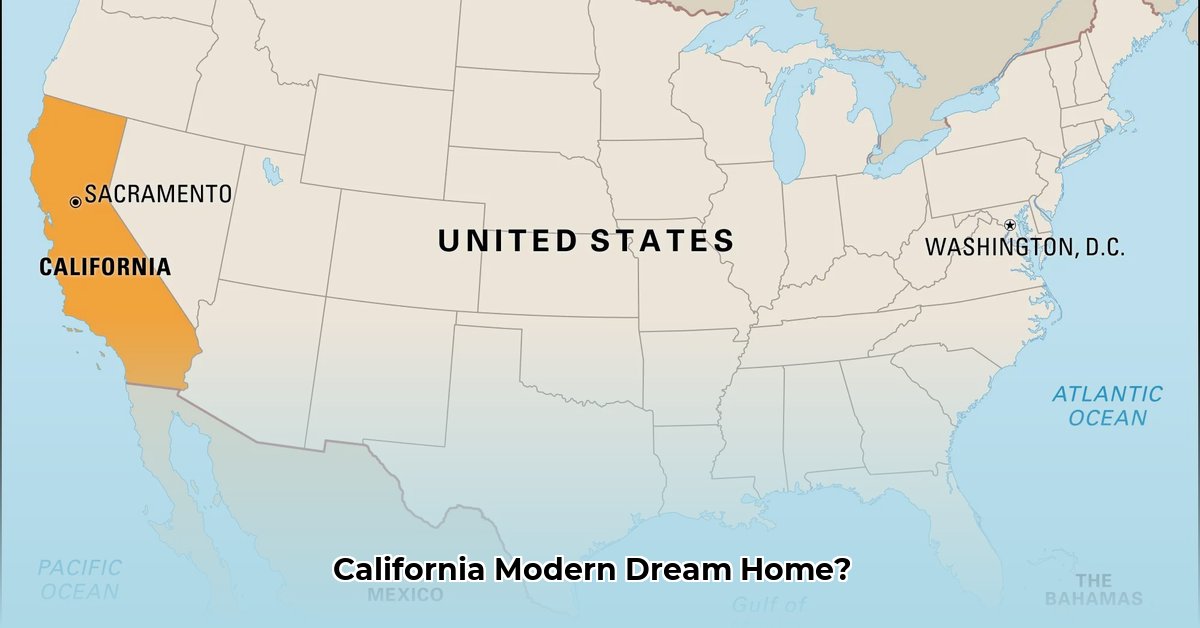Dreaming of a California modern home? It’s more than just sunshine and curb appeal; it’s a lifestyle! This guide unpacks the diverse styles – from the timeless Craftsman bungalow to cutting-edge contemporary masterpieces – that define California’s unique architectural landscape. Learn how to maximize natural light, seamlessly blend indoor and outdoor living, and navigate the practicalities of building in the Golden State, including seismic safety, wildfire resilience, and sustainable practices. Whether you’re a homeowner, builder, or architect, this resource equips you with the knowledge to create a stunning and functional California dream home.
California Modern House Design: Styles, Elements & Key Considerations
Delving into California Modern design requires understanding its wide range of styles and essential elements, like abundant natural light and fluid indoor-outdoor transitions. This iconic style also emphasizes sustainability and harmonious integration of diverse architectural influences.
Architectural Styles in California: A Diverse Palette
California’s architecture reflects its rich history, diverse cultural influences, and varied geography, offering a spectrum from charming bungalows to grand estates. Each style contributes to the state’s unique aesthetic appeal, featuring sun-drenched courtyards, natural redwood accents, and sleek, minimalist lines.
Let’s explore some defining styles:
- Craftsman: Offers warmth and handcrafted charm. Exposed beams, low-pitched roofs, and a connection to nature create inviting spaces that harmonise with California’s landscape. These homes often boast built-in furniture and artisan details that showcase fine workmanship.
- Mediterranean: Inspired by the Mediterranean coast, evokes relaxed elegance and warmth, with stucco walls, terracotta roof tiles, and arched doorways. Courtyards, fountains, and wrought-iron details enhance their allure.
- Arts & Crafts: With an emphasis on natural materials and handcrafted details, this style emphasizes functionality and a harmonious relationship between the home and its environment. Rich wood accents, intricate tilework, and custom lighting fixtures are common features.
- Mid-Century Modern: Characterized by clean lines, open floor plans, and expansive glass walls, this style emphasizes simplicity and functionality. Post-and-beam construction, flat roofs, and integration with the surrounding landscape are hallmarks.
- Contemporary: Encompasses diverse modern designs featuring clean lines, expansive windows, open floor plans, and minimalist aesthetics. These homes often showcase a wide range of building materials, with an emphasis on sustainability and energy efficiency.
These styles often blend together, creating unique and exciting designs. Imagine Craftsman details combined with a contemporary open-plan layout, or a Mediterranean villa incorporating sustainable materials. When considering your California home, what design best suits your lifestyle and embodies your aesthetic vision?
Core Design Elements: Capturing the Essence of California Living
The essence of California modern house design lies in its ability to evoke a sense of relaxed sophistication.
- Natural Light: Harnessing California’s abundant sunshine is paramount. Large windows, skylights, and glass doors are essential for flooding interiors with light, creating bright, airy spaces that foster a connection with the outdoors.
- Indoor-Outdoor Flow: Perhaps the most defining characteristic, this creates a seamless transition between interior and exterior living spaces. Expansive decks, patios, and covered porches become extensions of the home, inviting residents to enjoy the California climate year-round.
- Sustainable Materials: Environmentally conscious construction is increasingly important. Locally sourced wood, recycled materials, and low-VOC finishes minimize the home’s environmental impact.
- Energy Efficiency: Sustainability goes hand in hand with energy efficiency. Solar panels, high-performance insulation, energy-efficient windows, and smart-home technologies reduce energy consumption and create a comfortable living environment.
Building Considerations: Understanding California’s Unique Challenges
Building in California presents unique challenges, including seismic activity, wildfire risks, and water scarcity. Regulations vary significantly depending on your location, so understanding these rules early on is critical.
- Seismic Requirements: California’s location near major fault lines necessitates earthquake-resistant construction. This requires specialized engineering, reinforced foundations, and flexible building materials to withstand seismic forces.
- Wildfire Risks: In fire-prone areas, strict building codes mandate fire-resistant materials, defensible spaces around the house, and careful landscaping to mitigate wildfire risks. Features like fire-rated roofing, stucco exteriors, and ember-resistant vents are crucial.
- Water Conservation: Water is a precious resource in California, and regulations emphasize water-wise landscaping, efficient irrigation systems, and low-flow plumbing fixtures to minimize water consumption.
- Building Codes: Building codes vary by county and city. Research local codes before starting your project to avoid costly surprises and ensure compliance.
Roadmap for Success: From Vision to Reality
Designing and building your dream California modern home requires collaboration among key stakeholders: homeowners, architects, designers, builders, and local governments. Clear communication, meticulous planning, and adaptability are essential for a successful project.
| Stakeholder | Short-Term Actions | Long-Term Actions |
|---|---|---|
| Homebuyers | Determine budget and financing, research neighborhoods and property options, assemble a team of experienced professionals (architect, builder, designer), define lifestyle priorities and design preferences. | Monitor project progress, make informed decisions, explore smart-home technologies, and invest in landscaping and outdoor living spaces that enhance the home’s value. |
| Architects/Designers | Conduct site analysis, develop preliminary designs, incorporate sustainable design principles, ensure compliance with building codes, and collaborate with builders to refine construction documents. | Stay updated on building codes, invest in continuing education, and explore new materials, technologies, and design trends. |
| Builders/Contractors | Develop detailed cost estimates, secure necessary permits, manage the construction process, ensure quality control, and coordinate subcontractors. | Implement sustainable construction practices, invest in advanced technologies, and train teams on efficiency and safety protocols. |
| Local Governments | Streamline the permitting process, enforce building codes, and provide resources for homeowners and builders on sustainable building practices. | Invest in infrastructure, engage in public education campaigns, and update building codes to meet evolving environmental and technological challenges. |
Navigating California’s Building Codes: A Guide to Custom Home Design
California’s strict building codes are designed to protect you and the environment, and require planning to adhere to these regulations, promoting energy efficiency, earthquake resilience, and fire safety, while balancing design aesthetics and local regulations.
Key Takeaways:
- Building in California is challenging and requires careful planning.
- Strict codes prioritize energy efficiency, earthquake resilience, and fire safety.
- Understanding local regulations is critical for a smooth process.
- Sustainable materials and practices are increasingly important.
- Collaboration with experienced professionals is essential.
California Modern Design: Blending Aesthetics and Regulations
California Modern architecture seamlessly blends indoor and outdoor living with open floor plans, large windows, and natural materials, it embodies a distinctive aesthetic and a coveted lifestyle. Designing and building your dream California Modern home requires navigating a complex web of regulations. Let’s dive into how to navigate California building codes for custom home design.
Understanding California’s Building Codes: Protecting People and the Planet
California’s building codes are among the strictest in the nation, designed to protect you and the environment from earthquakes, wildfires, and water scarcity. Understanding these regulations is paramount for a successful project.
Key Code Areas: A Quick Overview
- Seismic Safety: Your design must withstand seismic activity. Working with structural engineers experienced in seismic design is essential and ensures your home can endure the forces of an earthquake.
- Wildfire Resistance: In fire-prone areas, building materials and landscaping are crucial. This includes fire-resistant roofing and siding, as well as creating defensible space around your property.
- Energy Efficiency: California prioritizes energy-efficient homes, which translates to specific requirements for insulation, windows, and HVAC systems. The California Energy Commission website provides detailed information and resources.
- Water Conservation: Designs must minimize water usage with drought-tolerant landscaping and low-flow fixtures. Protecting this precious resource is critical in California.
Streamlining the Process: Practical Steps
- Early Consultation: Engage an architect and builder early in the process to guide you through code requirements from the start.
- Permitting: The permitting process can be lengthy, so submitting complete and accurate applications will save valuable time.
- Material Selection: Choose materials that meet both code requirements and your design vision, while considering sustainability and resilience.
- Inspections: Be prepared for mandatory regular inspections, and address any issues promptly to keep your project on track.
- Compliance: Stay updated on code changes, as non-compliance can lead to delays and fines.
Balancing Design and Regulations: Finding Creative Solutions
Work with your team to find design solutions that meet both aesthetic goals and code requirements. It’s a challenging but rewarding process.
Local Variations and HOA Considerations: Navigating Additional Requirements
California’s diverse regions have distinct regulations. Cities or counties may have specific requirements, and if you’re in a community with a Homeowners Association (HOA), their rules will add another layer of considerations to your design.
Sustainable Material Selection for California Modern Homes
California Modern homes prioritize indoor-outdoor flow and natural light, sustainable material selection is essential for achieving these design goals while adhering to stringent building codes.
Key Takeaways:
- California Modern homes
- Glass Tile Shower Ideas to Create a Stunning Bathroom Space - December 7, 2025
- Glass Wall Tile Ideas for Kitchens and Bathrooms - December 6, 2025
- Glass Tile Bathroom: Create a Beautiful, Easy-Clean Space - December 5, 2025










